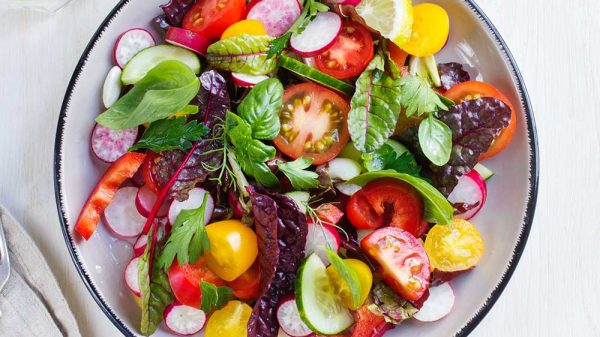If you have nonalcoholic fatty liver disease, it’s vital to alter your diet to support liver repair. This means cutting out added sugars, saturated and trans fats, sodium, and preservatives while adding lots of antioxidants, essential amino acids, and healthy fats from whole foods. You may be surprised to learn about the following unconventional foods good for liver regeneration that could give your body an extra boost when recovering from fatty liver disease.
1. Wasabi
Many of us are probably familiar with wasabi as the face-flushing, tear-jerking green paste that is included as a condiment for sushi. But what actually is wasabi? Wasabi – also called Japanese horseradish – is a plant that grows abundantly along rivers in Japan. The stem is the part of the wasabi plant that is most commonly grated into a paste and eaten.
It turns out that wasabi contains a potent antioxidant that may play a key role in mitigating inflammation and oxidative stress implicated in fatty liver disease. Allyl isothiocyanate is the curative compound in wasabi that may have implications for reversing liver damage.
Allyl isothiocyanate is categorized as a glucosinolate, a plant compound containing sulfur and exhibiting antioxidant properties. Allyl isothiocyanate has shown particular promise in supporting cells’ mitochondria, organelles that are responsible for producing energy in the form of adenosine triphosphate (ATP), and powering all cellular processes. In the case of fatty liver disease, dysfunctional mitochondria produce an inadequate supply of ATP and generate damaging reactive oxygen species. Malfunctioning mitochondria means a sluggish metabolism, contributing to fat accumulation in the liver. (1)
Consuming allyl isothiocyanate from wasabi may improve mitochondrial function and facilitate liver repair. A study conducted by researchers at the Korea Food Research Institute at the Korea University of Science and Technology investigated the effect of allyl isothiocyanate on obese mice with metabolic syndrome and fatty liver disease. Results revealed that the administration of allyl isothiocyanate was associated with more effective mitochondrial function as well as improvements in markers of metabolic syndrome and fatty liver disease. Mice who received allyl isothiocyanate lost weight and had reduced fat content in the liver. Furthermore, allyl isothiocyanate was found to improve insulin sensitivity. (2)
Of course, it’s difficult to consume lots of wasabi because of its strong, spicy flavor. To incorporate wasabi into your diet, it can be used as a condiment or a spicy additive. Try making a milder form of wasabi by mixing it into hummus, and using the combination as a dip for vegetables or a spicy spread for sandwiches.
2. Black Garlic
We’re accustomed to seeing garlic as firm, white cloves that are encased in a white flaky peel. This kind of fresh, raw garlic is a common ingredient used to add robust savory flavor to a variety of dishes.
Black garlic is made by subjecting fresh garlic to a fermentation process that involves exposure to heat over time. As expected, the white cloves turn black and the outer shell becomes crispy and turns brown in color. Black garlic is known to have a flavor that is milder and sweeter when compared to the more pungent fresh garlic.
A study published in Toxicology Research analyzed the impact of aged black garlic on liver health in rat models. Results determined that black garlic helped reduce inflammatory increases in liver enzymes aspartate transaminase (AST) and alanine transaminase (ALT). Researchers concluded that adding aged black garlic to a liver-healing diet and medical intervention may enhance any therapeutic effects. (3)
Where can you find black garlic and how can you incorporate it into your diet? You can find black garlic in gourmet grocery stores and at nutrition shops, as well as online. Black garlic has a subtler flavor than raw garlic and can be added to dressings and spreads to create a unique flavor profile that packs a liver-healing punch! You can also substitute black garlic for recipes that usually call for regular garlic. Black garlic can even be enjoyed by itself.
3. Kumquat
Kumquats are tiny citrus fruits that grow on small bushes in China, Japan, and Southeast Asia. Kumquats may be small in size, but they have huge health benefits for the liver.
A study conducted by researchers at Southwest University, Shanghai University of Traditional Chinese Medicine, Key Laboratory of Horticulture Science for Southern Mountainous Regions, and the Chinese Academy of Agricultural Sciences in China assessed the impact of kumquat extract on obese mice. Results found that kumquat extract helped improve glucose and fat levels, which could have important implications for treating fatty liver disease. (4)
Much like other citrus fruits, the kumquat is rich in antioxidants like vitamin C that promote healthy immune response while lowering inflammation. Consuming fruits rich in vitamin C can streamline your body’s healing mechanism to target liver damage and inflammation.
Kumquats are occasionally available in local grocery stores, but the best way to purchase kumquats is online or in specialty grocery stores. These mini citrus fruits are more sour than oranges, tangerines, and grapefruits, but not quite as sour as lemons and limes. Both the flesh and the peel can be eaten fresh. To make the sour taste a little more palatable, try blending whole kumquats in a blender with ice and the natural, sugar-free sweetener erythritol. Agave nectar is another low-glycemic sweetener. The resulting beverage is the perfect summer drink; refreshing and citrusy with liver protective effects.
4. Tofu
Tofu is a solid form of soy protein that resembles the texture of meat. Soy protein is derived from soybeans and is the primary source of protein found in tofu.
A study conducted by researchers at the University of Illinois found that administering soy protein to obese animal models helped to improve cell signaling which improved liver metabolic processes and lowered liver accumulation. (5)
Another study conducted by researchers at the University of Arkansas for Medical Sciences investigated the short-term administration of soy protein to obese rats. In comparison to casein-fed rats, soy-fed rats were found to have lower levels of liver enzymes as well as decreased liver fat accumulation. (6)
Though the mechanism for tofu’s liver-protective effects is unclear, it may be related to the fact that it contains all essential amino acids, is a rich source of fiber, and contains nearly no fat.
You can use tofu as a meat substitute in nearly all dishes. Tofu works well when cut into cubes as a protein source in stir fries, or thinly sliced as a meat substitute in sandwiches. Alternatively, try mashing up tofu to serve as ground meat in taco recipes and spaghetti Bolognese recipes.
5. Pistachios
Pistachios are small green nuts that are individually encased in hard shells. Research produced in Italy suggests that pistachios may play a role in mitigating fatty liver disease and promoting healthy metabolic functioning. (7)
Pistachios are packed with health-promoting nutrients like monounsaturated fats, carotenoids, resveratrol, and other polyphenols with powerful antioxidant properties. Snacking on pistachios may help decrease inflammation in the liver that contributes to fat accumulation, while also increasing the efficiency of metabolic functions in liver cells.
Pistachios alone make an excellent snack option when you’re on the go, or they work well when paired with dried fruit. They can also be used as a crunchy and nutritious salad topper.
More Tips for Supporting Liver Regeneration
These five foods alone are not miracle foods and are insufficient to support liver regeneration on their own. These foods must be added to a balanced, liver-friendly diet to produce maximum effects. Below is an outline of the crucial factors to support liver health and help reverse liver damage associated with fatty liver disease.
Base Your Diet on Whole Foods
Focusing on whole foods in your diet is crucial to lowering inflammation in your liver and reversing fatty liver disease. Here are a few guidelines to make sure you’re getting the nutrients you need.
- Eat a variety of fruits and veggies. Eating large amounts of different fruits and vegetables on a daily basis is critical for supporting liver health. Fruits and vegetables are packed with fiber, vitamins, minerals, and antioxidants like vitamin C, vitamin B, beta carotene, selenium, and polyphenols that help protect against inflammation and help reverse chronic liver disease. Examples of healing fruits blueberries, blackberries, cherries, kiwi, papaya, and tomatoes. Green vegetables like asparagus and spinach as well as cruciferous vegetables like kale, cauliflower, brussels sprouts, and broccoli are packed with antioxidant compounds that work as liver-cleansing agents.
- Eat beans, nuts, and seeds. Beans, nuts, and seeds contain lots of fiber that aids digestive health and promote healthy liver function. Beans, nuts, and seeds also contain antioxidants, healthy fats, and protein. In particular, walnuts are full of liver-protecting antioxidants as well as essential amino acids like leucine and valine. Flaxseeds and chia seeds are rich in the plant form of omega-3 fatty acids, alpha-linolenic acid (ALA), as well as essential amino acids alanine, phenylalanine, and valine.
- Eat whole grains. Whole grains are carbohydrate sources that are unprocessed or only minimally processed. Whole grains that are unprocessed retain lots of nutrients essential for liver repair, like protein, antioxidants, and fiber. The fiber present in whole grains helps sustain energy from carbohydrates and also promotes optimal gut health. Examples of whole grains you should eat for liver health include brown rice, quinoa, millet, buckwheat, and oats.
- Eat fatty fish and healthy oils in moderation. Though fruits, veggies, beans, nuts, seeds, and whole grains should make up the bulk of your diet, fatty fish and oils can afford healthy fats that support liver health. Salmon and mackerel contain healthy omega-3 fatty acids in the form of docosahexaenoic acid (DHA) and eicosapentaenoic acid (EPA) that help soothe liver inflammation and promote repair. Oils like olive oil contain lots of healthy monounsaturated fat.
- Lean meats and dairy. Lean meats and nonfat dairy should make up the smallest portion of your diet. Though lean cuts of meat and dairy are filled with essential amino acids, they don’t contain fiber or antioxidants that help reduce liver inflammation. When choosing meat, go for unprocessed, lean meats like chicken breast and turkey breast. Choose dairy products that are low in fat and sodium, like nonfat Greek yogurt.
Get a Balance of All Essential Amino Acids
Amino acids are the smallest components that make up protein. The amino acids that humans use are grouped into two categories: essential and nonessential. While the body is able to synthesize nonessential amino acids using starting materials in the body, it is unable to synthesize essential amino acids from scratch, requiring us to get them from the foods we eat. If one essential amino acid is missing from your diet, the others aren’t able to do their job effectively.
The nine essential amino acids include histidine, threonine, methionine, lysine, leucine, isoleucine, valine, phenylalanine, and tryptophan. Your body requires all essential amino acids in optimal ratios to function. For example, all nine essential amino acids are needed to synthesize muscle tissue. However, if a single essential amino acid is missing, the body will have a difficult time creating muscle tissue, which may lead to muscle wasting. Maintaining muscle mass is particularly crucial if you have an advanced form of liver disease, to boost immune system function and help the body repair the liver.
Single food sources that contain all essential amino acids in optimal ratios include fish, lean meats, and dairy products. Soybeans and tofu are plant sources that contain all essential amino acids. If you are relying on other plant products for protein – like whole grains, beans, nuts, and seeds – make sure you eat a variety of these foods throughout the day to get all essential amino acids you need to promote liver repair. Most sources of plant protein are lacking at least one amino acid, called the limiting amino acid.
Eliminate Alcohol
When you consume alcohol, the liver works hard to detoxify it and produces harmful metabolic byproducts like acetaldehyde that impact normal functioning. Alcohol is an extremely irritating and inflammatory substance for the liver and the detoxification process also produces reactive oxygen species. These reactive particles – also known as free radicals – interact with healthy tissues and cause damage referred to as oxidative stress. Oxidative stress inhibits the efficient functioning of liver cells. As a result, the liver’s metabolic functions become sluggish and ineffective. Cutting alcohol out of your diet ensures that your body can focus on repair, instead of spending energy on detoxifying poisonous substances.
Use Herbs and Spices for Liver Cleansing
Certain herbs and spices are cleansing for the liver and help liver cells repair. Try adding these natural elixirs to your regimen:
- Green tea: Green tea is filled with liver-healing polyphenols called catechins. The catechin that is most well-known for its healing properties is epigallocatechin gallate (EGCG). EGCG works as an antioxidant, helping to clear waste from liver cells so they can operate efficiently. EGCG effectively helps scavenge reactive free radicals that have accumulated as waste in cells, as a byproduct of metabolic processes. Try adding a couple of cups of green tea to your morning routine. Not only is green tea packed with antioxidants, but it also contains caffeine to give you a boost of energy in the mornings.
- Turmeric: Turmeric is a bright-yellow spice that has been used in Asia for centuries. Turmeric is most well-known as an important ingredient in curry powder, though it can also be used in other flavor profiles. Like green tea, turmeric is a potent antioxidant that helps quell liver inflammation and prevent fatty liver disease from progressing. Turmeric has been revered for its healing properties to treat seasonal allergies, brain fog, and liver diseases. You can even brew turmeric tea or sprinkle it into smoothies for an extra boost of antioxidants. Keep in mind that turmeric is best absorbed in the body when it is taken with a small amount of black pepper. When cooking with turmeric, make sure to add a little black pepper into the recipe as well.
- Oregano, basil, and thyme: These traditional Italian herbs may be tasty, but they are also packed with antioxidants from polyphenols. Sprinkle dried herbs over whole-grain pasta dishes, lentil stews, and other recipes to add an extra boost of antioxidants.
- Coffee: Coffee may already be a part of your daily routine, and if so, you should keep it that way! Coffee has potent anti-inflammatory effects that help prevent fatty liver disease progression as well as help reverse fat accumulation. In fact, coffee has been shown to lower elevated liver enzyme levels associated with liver inflammation. Just make sure you’re drinking the healthiest coffee possible, without added sugars and fatty dairy products.
- Dandelion: Dandelion is a beautiful wildflower that also has liver-cleansing properties. Regularly drinking a cup of dandelion root tea helps to clean out a sluggish liver and support liver metabolic processes.
- Milk thistle: Milk thistle is a healing herb that has many health benefits for the liver. Flavonoids are the primary therapeutic antioxidant in milk thistle and help protect the liver from damage and inflammation related to fatty liver disease. You can benefit from the protective properties of milk thistle by drinking milk thistle tea or taking a supplement. Keep in mind that milk thistle may interact with certain medications. Before adding supplements to your regimen, be sure to check with your doctor to make sure any supplements work for your specific conditions.
Avoid Liver-Damaging Medications
Some prescribed medications, as well as over-the-counter medications, may cause inflammation in the liver. For example, acetaminophen, when taken in too large a dose, is toxic for the liver. Certain antibiotics and antiviral medications may also increase inflammation in the liver. Statins, a medication used to treat cholesterol levels and metabolic syndrome, may also contribute to liver inflammation and elevated liver enzymes. Talk to your health care provider about alternative medications that don’t harm the liver.
Address Any Underlying Conditions
Conditions like type 2 diabetes, insulin resistance, hepatitis C, or autoimmune hepatitis contribute to liver inflammation and fatty liver disease. If you have co-occurring health conditions, it’s crucial to get them under control. Make sure you’re following the advice of your physician when it comes to establishing the best health care regimen that works for your needs.
Conclusion
Wasabi, black garlic, kumquat, tofu, and pistachios are five foods that promote healing from fatty liver disease that you may not have expected. In order to make the most of these foods’ therapeutic properties, make sure you follow a balanced diet that promotes the reversal of fatty liver disease by including lots of antioxidants, healthy fats, and essential amino acids. Layering these foods on top of a fundamentally liver-friendly diet will make sure you get the best results possible.

References:
(1) https://www.ncbi.nlm.nih.gov/pmc/articles/PMC5483489/
(2) https://www.ncbi.nlm.nih.gov/pubmed/25034503
(3) https://www.ncbi.nlm.nih.gov/pmc/articles/PMC4007044/
(4) https://www.ncbi.nlm.nih.gov/pmc/articles/PMC3976270/
(5) https://www.ncbi.nlm.nih.gov/pmc/articles/PMC3690171/























